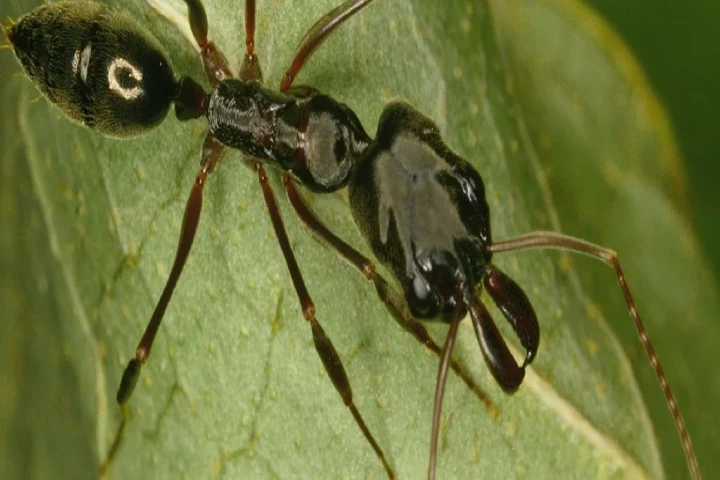

Trap Jaw Ant whose snap is the second fastest in the animal kingdom (Pic. Courtesy wikimedia commons)
<p>
<strong>Trap-jaw ants are known for their fast and powerful mandibles which simply kill or maim the prey, enabling the predator to take the prey back to its nest. What is amazing is that these ants can lock and snap their jaws again in case one bite doesn&rsquo;t suffice.</strong></p>
<p>
As per a report in sciencealert.com, these creatures run the risk of hurting themselves with such a fast-moving mechanism yet that doesn&rsquo;t happen making these ants among the quickest snap in the animal kingdom.</p>
<p>
United States based scientists by using mathematical modelling of the structure of Odontomachus brunneus or trap-jaw ant species&rsquo; head found out how its jaws cope with the insane forces that shut them.</p>
<p>
The scientists were aware that the creature&rsquo;s mandibles are spring-powered levers, each of which are locked by a latch that is let go the second a prey touches the sensory hairs on the inside of the mandibles.</p>
<p>
The latch-mediated spring actuation (LaMSA) is common among small species. With the size reducing, the elastic energy scales are far more effective and efficient than complex biochemical motors. Yet, the force generated by a small LaMSA can cause risk to the materials or structure which is holding it together.</p>
<p>
The fastest snap is recorded by the Dracula ant or Mystrium camillae, which can swing the parts of its mouth shut at 320 kilometres per hour. Thus, it holds the top position for the fastest moving body part in nature. Trap-jaw ants are second to them as they score 196 km per hour. To be able to generate this speed, they rotate each mandible at an equivalent of 470,000 rpm, providing a slicing action that gets hold of the prey in microseconds.</p>
<p>
Yet, these same jaws are capable of light and tender manoeuvres like moving around their young ones and other objects and materials with agility.</p>
<p>
This shift in role by the jaws — from being the fast-snapping ones to becoming precise &ndash; intrigued and amazed scientists. This prompted them to film the ant&rsquo;s high-speed action to understand it better.</p>
<p>
Sharing details about it, Sheila Patek who is a biologist at Duke University said: <a href="https://www.sciencealert.com/trap-jaw-ants-risk-blowing-themselves-apart-when-they-hunt-here-s-why-they-don-t?utm_source=ScienceAlert+-+Daily+Email+Updates&amp;utm_campaign=62a0e48121-MAILCHIMP_EMAIL_CAMPAIGN&amp;utm_medium=email&amp;utm_term=0_fe5632fb09-62a0e48121-366100389" rel="nofollow">&quot;When we played back</a> the videos in slow-motion, their strikes were spectacularly precise. We realized that the entire head was deforming to store elastic potential energy.&rdquo;</p>
<p>
The researchers viewed the footage and saw that each of the mandibles kept a perfect arc for the first 65 degrees before decelerating towards the end of the swing. The point at which the mandibles closed, the creature&rsquo;s head was pulled out of shape &ndash; it became short by a little over 3 per cent and shrinking by 6 percent.</p>
<p>
How was this massive force generated? Biomechanical models show that the energy for half of the swing came from the warping of the exoskeleton itself while the rest was provided by a tendon pulled into tension with the help of a big muscle which is located deep inside the head.</p>
<p>
These muscles are stationed to the inside of the ant&rsquo;s head and hold each of the mandibles keeping them ready to go. The moment something sets the trigger, the latch lets go the energy that is stored in the tendon to pull the vital side of the mandible backward, launching the tip at speed.</p>
<p>
While this is going on, the ant&#39;s deformed head snaps back into shape moving the mandible&rsquo;s front to provide that extra force.</p>
<p>
Thus, these two respective actions &ndash; the shrinking tendon&rsquo;s pull and the relaxing exoskeleton&rsquo;s push &ndash; provide the required speed but also steer the mandibles with precision which is necessary to dissipate energy evenly, thus minimising the chances of a critical failure.</p>
<p>
Knowing this mechanism can have a bearing on our engineering to create technologies that have strike the correct balance between speed and precision.</p>
<p>
Details of this research was published in the Journal of Experimental Biology.</p>
Politicians and human rights organizations have called on the European Union (EU) to suspend Pakistan's…
Prime Minister Narendra Modi who is on a State visit to Thailand was gifted the…
Prime Minister Narendra Modi on Thursday held delegation-level talks with his Thai counterpart Paetongtarn Shinawatra…
Adding new vigour to the bilateral friendship, Prime Minister Narendra Modi had a productive meeting…
Defence Minister Rajnath Singh flagged off expeditions to Mount Everest (8,848m) and Mount Kangchenjunga (8,586m)…
The World Uyghur Congress (WUC) has announced the upcoming Third East Turkistan/Uyghur Summit, along with…